Best Practices for Building Employee Recognition Budgets
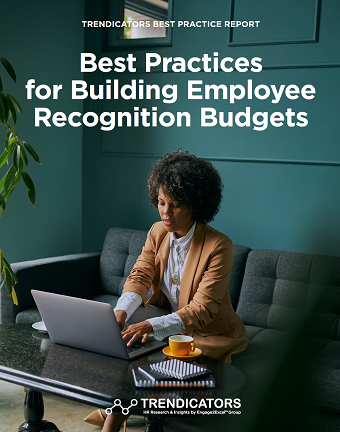
INTRODUCTION
Do you know how much your organization spends on the many different types of employee recognition each year? In this best practice report, we provide practical guidance for building your employee recognition budget and your strategy for tracking, managing and ensuring accountability for the alignment of recognition programs with enterprise goals and objectives. A first step in building an enterprise employee recognition budget is to arrive at a definition for what recognition is and why it matters to your organization.
Budgeting begins with a definition of employee recognition and how it influences organizational objectives.
Use the definition below as a starting point. On the following pages, you’ll find insights and examples that will help you:
- Decide which types of recognition to include in your budget
- Ensure maximum program participation
- Choose a model for program management
- Make success-based investments
- Determine how much to invest
Trendicators is the research division of Engage2Excel, a leading provider of employee recognition, engagement survey and talent acquisition solutions. Trendicators provides original research, along with reports on insights and best practices from industry leaders and experts.
Employee recognition is the acknowledgment of a company’s staff for exemplary performance and tenure with the organization. The goal of employee recognition is to reinforce particular behaviors, practices or activities that result in better performance and positive business results.
Download
 hbspt.cta.load(123973, 'a88bb0b5-09d1-4534-a25c-0db33457ad80', {"useNewLoader":"true","region":"na1"});
hbspt.cta.load(123973, 'a88bb0b5-09d1-4534-a25c-0db33457ad80', {"useNewLoader":"true","region":"na1"});
Decide which types of recognition will be included in your budget
In the modern workforce, employees have greater autonomy and influence over business outcomes than ever before. This is because technology has changed the way we work. Interconnectedness means that organizations rely less on hierarchical structures in favor of greater collaboration. As a result, the behaviors of individuals and the ability to influence them becomes central to every organization’s success.
The goal of your employee recognition strategy should be to reinforce the behaviors and activities that drive business results. Successful recognition strategies include programs designed to accomplish different objectives. Service awards express widespread appreciation for loyalty. Performance recognition programs target behaviors aligned with specific business objectives. Social recognition enables employees to celebrate one another on a peer-to-peer basis. And onboarding and preboarding programs provide reinforcement at a time when the risk of voluntary turnover is highest.
Nearly 90% of employers offer some form of formal employee recognition program.¹
SERVICE AWARDS: Service award programs celebrate career milestones beginning in year one. These programs positively impact engagement levels and are overwhelmingly favored by all employee groups, including 80% of 25- to 34-year-olds.
PERFORMANCE RECOGNITION: Performance recognition programs address challenges and opportunities tied to strategic business objectives, such as driving innovation, improving collaboration, enhancing workplace safety and increasing workgroup efficiency.
SOCIAL RECOGNITION: Social recognition programs bring an important cultural dimension to employee recognition by adding social reinforcement to the demonstration of important behaviors and corporate values and amplifying recognition across the organization.
ONBOARDING RECOGNITION: Onboarding recognition programs help you create fulfilling experiences that assimilate new employees into your culture and reduce time to productivity. Preboarding programs welcome new hires before their first day on the job.
1. Trends in Employee Recognition, WorldatWork Survey Report
Download
 hbspt.cta.load(123973, 'a88bb0b5-09d1-4534-a25c-0db33457ad80', {"useNewLoader":"true","region":"na1"});
hbspt.cta.load(123973, 'a88bb0b5-09d1-4534-a25c-0db33457ad80', {"useNewLoader":"true","region":"na1"});
Ensure widespread engagement with an inclusive approach to program design
While the goal of employee recognition is to influence behaviors, the means by which this is achieved is through employee engagement. Effective recognition programs ensure widespread engagement with an inclusive approach to program design.
Most organizations have a broad range of employee recognition activities that take place on any given business day. As the role of recognition in facilitating employee engagement has become increasingly important, so has the need for ensuring accountability and alignment with enterprise objectives. In designing your recognition strategy, make sure that you include a diverse mix of recognition programs to ensure widespread participation.
Metrics-based recognition celebrates goal achievement in alignment with enterprise strategy. Peer-nominated recognition gives power to individual employees to acknowledge exceptional effort. Manager-nominated recognition provides important individual and team-based incentives. Celebrating service and life events helps to create a culture of appreciation and ensures enterprise-wide participation.
Our survey of 5,000 employees revealed that 70% believe performance feedback from other members of their team is as important as feedback from their manager.²
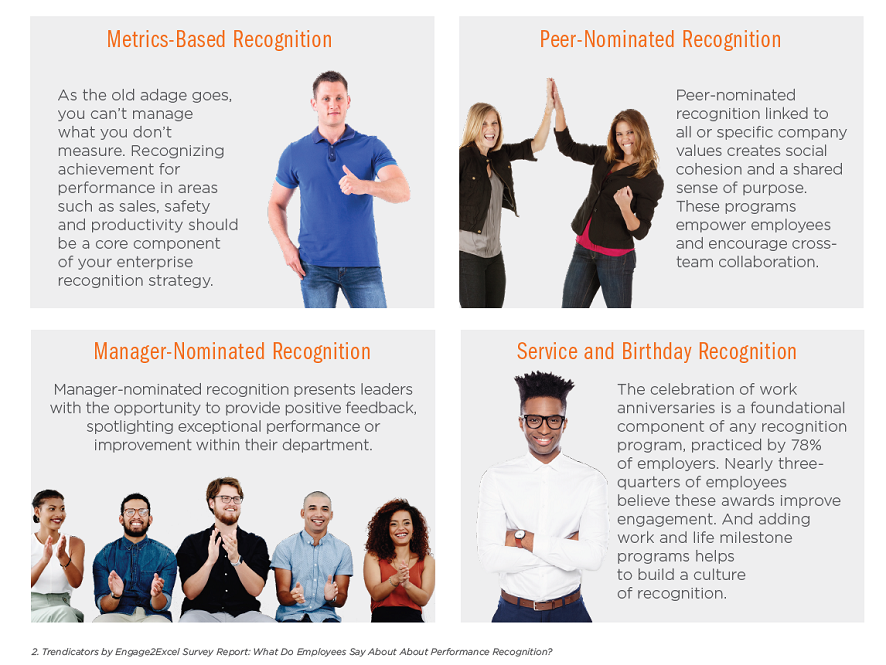
Download
 hbspt.cta.load(123973, 'a88bb0b5-09d1-4534-a25c-0db33457ad80', {"useNewLoader":"true","region":"na1"});
hbspt.cta.load(123973, 'a88bb0b5-09d1-4534-a25c-0db33457ad80', {"useNewLoader":"true","region":"na1"});
Decide which model for program management will work best for your organization
If your organization does not have a well-established, enterprise-wide employee recognition strategy in place, you will need to decide on a model for program management to facilitate change management and ensure accountability. The question is, which model will best suit your organization in creating a culture of recognition?
In the centralized model, responsibilities for program design, budgeting and organizational alignment are centralized in, and owned by, a dedicated group within an organization. This central team is responsible for working with a recognition platform service provider, vetting ideas, soliciting internal feedback, establishing program guidelines and promoting recognition programs.
Under the decentralized model, responsibilities for recognition program design and management are fully distributed among divisions, business units or departments. The challenge with this approach to recognition program design and management is that it lacks scalability and can significantly increase costs.
The federated model is similar to a centralized model, except that key members of the central innovation team are embedded in the business units. Recognition program managers in the business units are responsible for funneling ideas to the central team, as well as for creating awareness and testing the concepts developed by the central team.
Human Resources departments administer recognition programs in half of all organizations; 25% of programs are managed by Compensation departments.³
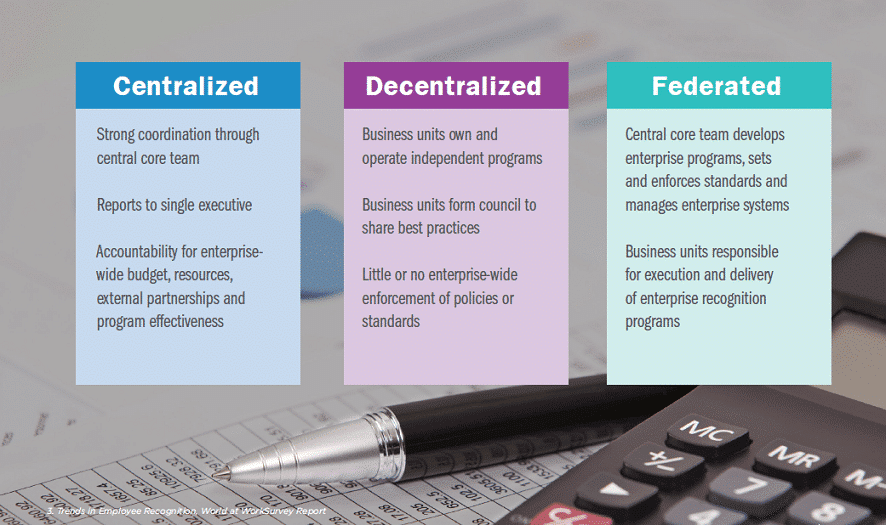
Download
 hbspt.cta.load(123973, 'a88bb0b5-09d1-4534-a25c-0db33457ad80', {"useNewLoader":"true","region":"na1"});
hbspt.cta.load(123973, 'a88bb0b5-09d1-4534-a25c-0db33457ad80', {"useNewLoader":"true","region":"na1"});
Allocate 5% to 10% of your budget for opportunistic or success-based investment
It is a simple fact that some of your organization’s investments in employee recognition will generate greater participation and results than others. In some cases, under-performing programs may need additional resources to raise awareness and boost participation rates. Other programs may exceed expectations and merit additional funding in order to maximize impact.
Reserving a percentage of your overall budget to address these realities is prudent and promotes a much higher level of accountability
by program managers.
Modern recognition and rewards platforms have greatly simplified the logistics of tracking and managing different types of programs and
budget allocations.
Another advantage of reserving a percentage of your overall budget is the ability to fund unanticipated needs or opportunities for influencing or recognizing employee behavior. Examples can include a natural disaster where employees are called upon to volunteer in relief efforts or an unexpected business challenge that requires above and beyond initiative from team members across different departments.
Budget holdbacks are an effective way to optimize your investment in employee recognition programs.
Create an agile culture of recognition by rewarding programs that exceed expectations with additional funding and responding to extraordinary events or circumstances throughout the year.
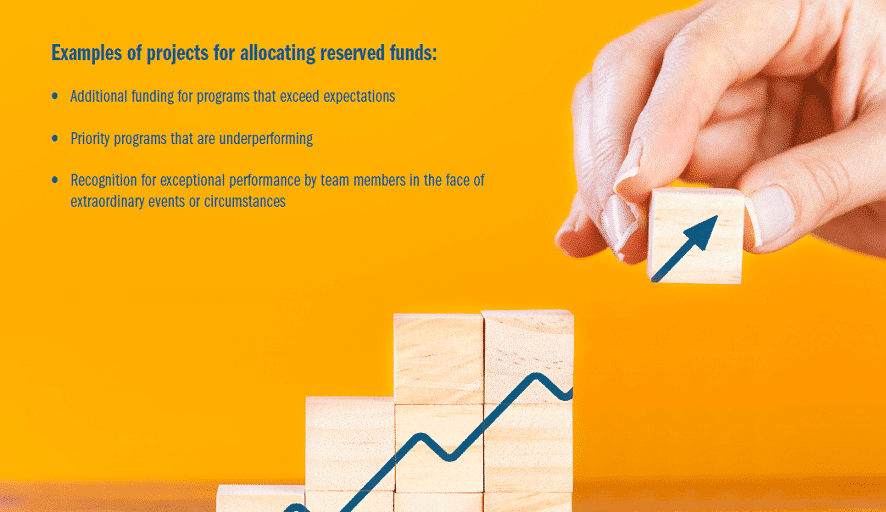
Download
 hbspt.cta.load(123973, 'a88bb0b5-09d1-4534-a25c-0db33457ad80', {"useNewLoader":"true","region":"na1"});
hbspt.cta.load(123973, 'a88bb0b5-09d1-4534-a25c-0db33457ad80', {"useNewLoader":"true","region":"na1"});
Enlist business stakeholders to align recognition with enterprise objectives
No matter which model you choose for program design and management, enlisting input from key stakeholders within your organization will be an important way to ensure alignment with business objectives. It also presents an opportunity for identifying important business objectives that can benefit from a structured recognition program to facilitate change management.
Building a high-level architectural view of employee recognition programs and programming opportunities is a great way to help stakeholders understand the strategic value of recognition. Create a one-sentence definition of your goal for employee recognition programming at the center of the diagram. List programs available for all employees on the left and programs that target specific departments or operational functions on the right.
Current programs, such as service awards and recognition of enterprise values, should be evaluated annually. If you are not currently recognizing employee participation in health and wellness and community service programs, meet with the stakeholders responsible for these areas and your recognition service provider to discuss ways that a formal program can boost participation.
Programs that target specific departments or functions are often administered independently, without the benefit of formal program management. Performance recognition programs take many different forms and cut across all departments. Bringing these and other programs for improving safety, quality and customer service onto a single recognition platform helps to ensure accountability for budgets, participation and program effectiveness or impact.
In evaluating the current state of recognition within your organization, you will likely find many opportunities for improving program effectiveness and organizational alignment.
The average organization uses eight separate types of employee recognition programs.⁴
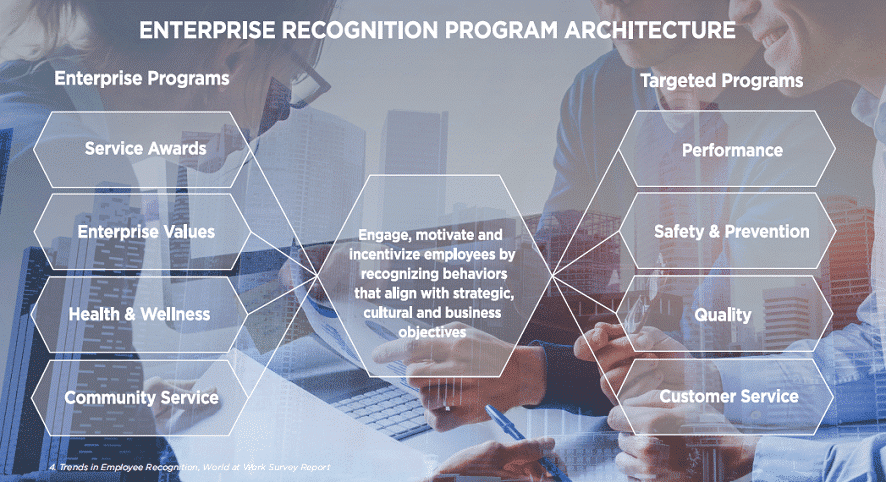
Download
 hbspt.cta.load(123973, 'a88bb0b5-09d1-4534-a25c-0db33457ad80', {"useNewLoader":"true","region":"na1"});
hbspt.cta.load(123973, 'a88bb0b5-09d1-4534-a25c-0db33457ad80', {"useNewLoader":"true","region":"na1"});
Common methods for calculating your employee recognition budget
There are several ways to determine a budget for incentive and recognition programs. As employers realize that one program does not fit all, many are moving toward the trend of budgeting per program. Different “sub-audiences” in the employee population need to be acknowledged and rewarded for different results with different rule structures.
The three most common approaches for building employee recognition budgets are described below.
The non-redemption of points is another budget consideration in point programs. Not all points issued to employees are actually used to order awards. Non-redemption is usually in the 10% to 15% range and should be used in budget calculations. Also consider whether your incentive or recognition partner is billing on a points-redeemed model or a points-issued model. While there are cost benefits to both, it is important to understand which model will work best with your budgeting needs.
When budgeting for performance-based programs, it is important to take into consideration the tax implications for the employee. Tax issues vary by state and by type of award and are subject to federal regulations. To help with this expense, most employers “gross up” the awards to alleviate additional tax burdens on their employees. Best practices dictate that employers use Fair Market Value (FMV) calculations to reduce the taxable value of the award to the employee and therefore reduce the amount spent on gross up.
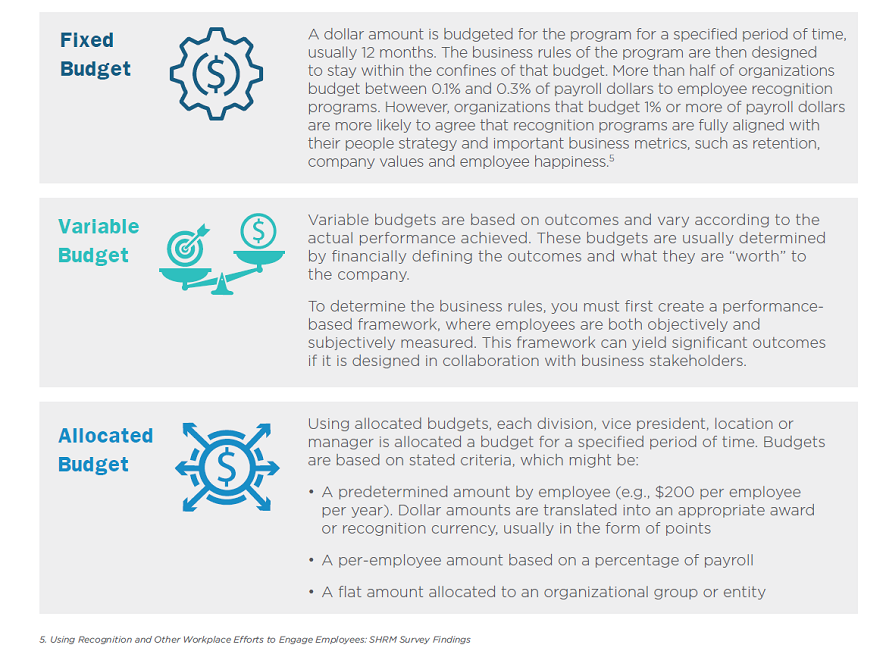
Download
 hbspt.cta.load(123973, 'a88bb0b5-09d1-4534-a25c-0db33457ad80', {"useNewLoader":"true","region":"na1"});
hbspt.cta.load(123973, 'a88bb0b5-09d1-4534-a25c-0db33457ad80', {"useNewLoader":"true","region":"na1"});
Four ways to improve the effectiveness of your investment in employee recognition
Make your program an investment and not an expense. Recognition programs are most successful when they align with overall corporate strategies. Creating programs that tie into your organization’s business objectives, mission, vision and values are more likely to be embraced by all levels of management. Corporate leadership teams will defend investments they believe will help grow the business and deliver profits to shareholders.
Looking for ways to improve the effectiveness of your organization’s investment in recognition? Here are four ways to improve program effectiveness.
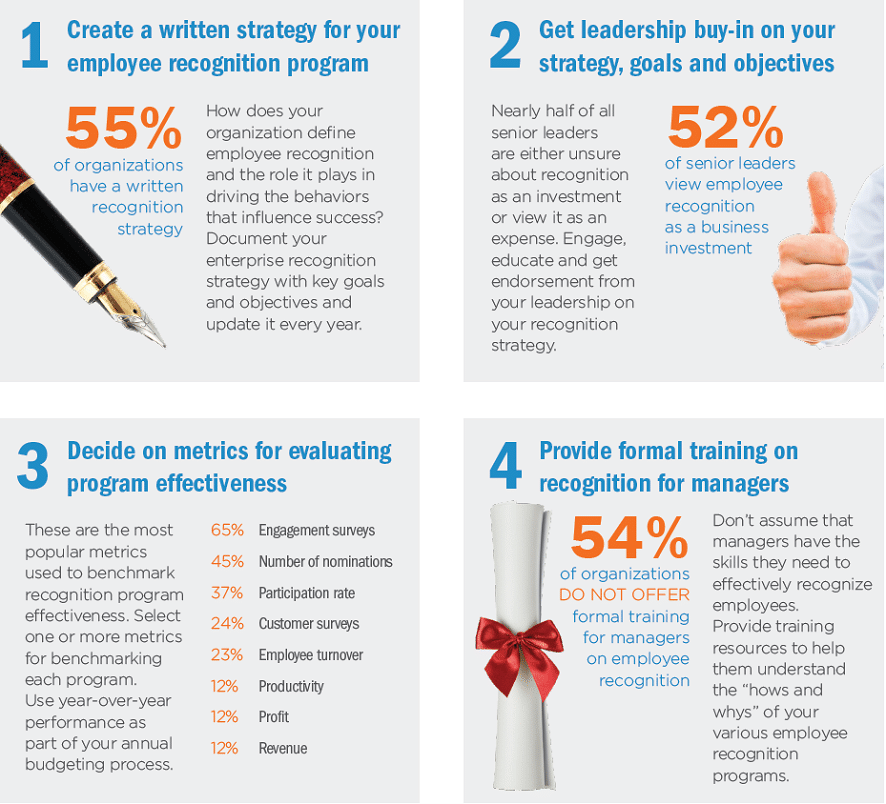
Download
 hbspt.cta.load(123973, 'a88bb0b5-09d1-4534-a25c-0db33457ad80', {"useNewLoader":"true","region":"na1"});
hbspt.cta.load(123973, 'a88bb0b5-09d1-4534-a25c-0db33457ad80', {"useNewLoader":"true","region":"na1"});
Want professional help in building your budget model?
The recognition experts at Engage2Excel can help you build a budget model that takes into account the number of employees, average participation rates, investment per recognition type and other key data, based on our experience in working with organizations of all sizes in all industries. We offer a no-obligation consultation session and provide a professionally-built spreadsheet that you can use for internal review and refinement.
To schedule a no-obligation budget consultation:
Call 1.800.688.3024 or email info@engage2excel.com
Download
 hbspt.cta.load(123973, 'a88bb0b5-09d1-4534-a25c-0db33457ad80', {"useNewLoader":"true","region":"na1"});
hbspt.cta.load(123973, 'a88bb0b5-09d1-4534-a25c-0db33457ad80', {"useNewLoader":"true","region":"na1"});